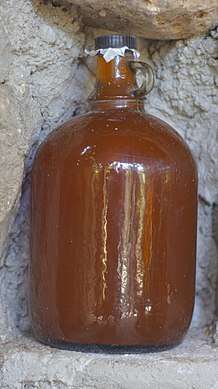Palm wine
Palm wine, known also as toddy, is an alcoholic beverage created from the sap of various species of palm tree such as the palmyra, date palms, and coconut palms.[1][2] It is known by various names in different regions and is common in various parts of Asia, Africa, the Caribbean, South America, and Micronesia.
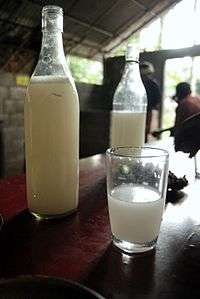 | |
| Type | Alcoholic beverage |
|---|---|
| Country of origin | Worldwide |
Palm wine production by smallholders and individual farmers may promote conservation as palm trees become a source of regular household income that may economically be worth more than the value of timber sold.[3]
Palm wine is known as matango, mbuh, tumbu liquor, white stuff in Cameroon; emu, nkwu, in Nigeria; poyo in Sierra Leone, nsamba in the Democratic Republic of the Congo; "Manjenvo" in Cabinda Angola; nsafufuo in Ghana;[4] "Taadi" in North India, Sendi in Kannada, Kali in Tulu, "Thati Kallu" (కల్లు) in Telugu, "Kal" (கள்) in Tamil and "Kallu" (കള്ള്) in Malayalam; Htan Yay (ထန်းရည်) in Myanmar; and Toddy in Malaysia and Sri Lankan English; mnazi in the Mijikenda language of Kenya; bahar (Kadazan-Dusun) and goribon (Rungus) in Sabah, Borneo; vino de coyol in Central America; tuba in the Marianas; and tubâ in the Philippines and Mexico as well as in Borneo. On the island of Leyte in the central Philippines, the red tubâ is aged with the tan bark for up to six months to two years, until it gets dark red and tapping its glass container gives off a deep hollow sound. This type of tubâ is called bahal (for tubâ aged this way for up to six months) and bahalina (for tubâ aged thus for up to a year or more). Toddy is also consumed in Sri Lanka and Myanmar, where in Sri Lanka it is known in sinhalese as thal ra (තල් රා), kithul ra (කිතුල් රා), or pol ra (පොල් රා).
Tapping


The sap is extracted and collected by a tapper. Typically the sap is collected from the cut flower of the palm tree. A container is fastened to the flower stump to collect the sap. The white liquid that initially collects tends to be very sweet and non-alcoholic before it is fermented. An alternative method is the falling of the entire tree. Where this is practised, a fire is sometimes lit at the cut end to facilitate the collection of sap.
Palm sap begins fermenting immediately after collection, due to natural yeasts in the air (often spurred by residual yeast left in the collecting container). Within two hours, fermentation yields an aromatic wine of up to 4% alcohol content, mildly intoxicating and sweet. The wine may be allowed to ferment longer, up to a day, to yield a stronger, more sour and acidic taste, which some people prefer. Longer fermentation produces vinegar instead of stronger wine.[5]
Distilled
Palm wine may be distilled to create a stronger drink, which goes by different names depending on the region (e.g., arrack, village gin, charayam, and country whiskey).
Throughout Nigeria, this is commonly called ogogoro. In some parts of Cameroon, it is known as Afofo. In parts of southern Ghana distilled palm wine is called akpeteshi or burukutu. In Togo and Benin it is called sodabe, while in Tunisia it is called lagmi. In coastal parts of Kenya, it is known as "chang'aa". Chang'aa can be applied to wounds to stop heavy bleeding (mechanism of action not known). In Ivory Coast, it is called "koutoukou".
In the Philippines, the most common distilled palm liquor is lambanog which is made from aged tubâ. It has very high alcohol by volume, at 40 to 45% abv (80 to 90 proof).[6][7]
Consumption by region
Africa
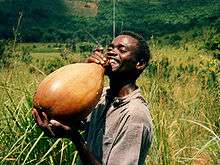
In Africa, the sap used to create palm wine is most often taken from wild datepalms such as the silver date palm (Phoenix sylvestris), the palmyra, and the jaggery palm (Caryota urens), or from oil palm such as the African Oil Palm (Elaeis guineense) or from Raffia palms, kithul palms, or nipa palms. In part of central and western Democratic Republic of the Congo, palm wine is called malafu. Palm wine tapping is mentioned in the novel Things Fall Apart by the Nigerian writer Chinua Achebe and is central to the plot of the novel The Palm Wine Drinkard by Nigerian author Amos Tutuola. Palm wine plays an important role in many ceremonies in parts of Nigeria such as among the Igbo peoples, and elsewhere in central and western Africa. Guests at weddings, birth celebrations, and funeral wakes are served generous quantities. Palm wine is often infused with medicinal herbs to remedy a wide variety of physical complaints. As a token of respect to deceased ancestors, many drinking sessions begin with a small amount of palm wine spilled on the ground (Kulosa malafu in Kikongo ya Leta). Palm wine is enjoyed by men and women, although women usually drink it in less public venues.
In parts of southeastern Nigeria, namely Igboland, palm wine is locally referred to as "mmanya ocha" (literally, "white drink"), with "ngwo" and "nkwu" variants. It plays a very important role in traditional Igbo settings. In Urualla, for instance, and other "ideator" towns, it is the drink of choice for traditional weddings. A young man who is going for the first introduction at his in-laws’ house is required to bring palm wine with him. There are varying gallons of palm wine required, depending on the customs of the different regions in Igboland. This culture can be observed in a similar fashion in the neighbouring north-western regions of Cameroon. (North West Region).
There are four types of palm wine in the central and southern Democratic Republic of the Congo. From the oil palm comes ngasi, dibondo comes from the raffia palm, cocoti from the coconut palm, and mahusu from a short palm which grows in the savannah areas of western Bandundu and Kasai provinces.
India
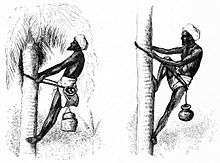
In India and South Asia, coconut palms and Palmyra palms such as the Arecaceae and Borassus are preferred. It is mainly produced from the lala palm (Hyphaene coriacea) by cutting the stem and collecting the sap. In some areas of India, palm wine is evaporated to produce the unrefined sugar called jaggery.
.jpg)
In parts of India, the unfermented sap is called neera (pathaneer in Tamil Nadu) and is refrigerated, stored and distributed by semi-government agencies. A little lime (calcium hydroxide) is added to the sap to prevent it from fermenting. Neera, similar to fruit-juice products, is relatively rich in potassium.
In India, palm wine or toddy is served as either neera or pathaneer (a sweet, non-alcoholic beverage derived from fresh sap) or kallu (a sour beverage made from fermented sap, but not as strong as wine).[8] Palm sap contains natural yeasts, which perform the fermentation of glucose to alcohol, as well as acetobacter, which subsequently converts the alcohol to acetic acid (vinegar). Optimal consumption time is one day after tapping, when the vinegar content is minimal; beyond this time, it becomes increasingly sour. Some palm wine drinkers prefer their beverage more sour than usual, but fermenting for too long will result in vinegar rather than wine. Refrigeration extends beverage life, as do a variety of spices, which also contribute flavor.
In India, palm wine is usually available at toddy shops (known as Kallu Shaap in [Malayalam], Kallu Kadai in [Tamil], Kalitha Gadang in Tulu, Kallu Dukanam in Telugu, Kallu Angadi in Kannada or "Liquor Shop" in English). In Tamil Nadu, this beverage is currently banned, though the legality fluctuates with politics. In the absence of legal toddy, moonshine distillers of arrack often sell methanol-contaminated alcohol, which can have lethal consequences. To discourage this practice, authorities have pushed for inexpensive "Indian Made Foreign Liquor" (IMFL).
In states of Telangana, Andhra Pradesh (India), toddy is a popular drink in rural parts that is frequently consumed at the end of the day after work.
There are two main types of kallu in states of Telangana and Andhra Pradesh, namely Thadi Kallu (from Toddy Palmyra trees) and Eetha Kallu (from silver date palms). Eetha Kallu is very sweet and less intoxicating, whereas Thati Kallu is stronger (sweet in the morning, becoming sour to bitter-sour in the evening) and is highly intoxicating. People enjoy kallu right at the trees where it is brought down. They drink out of leaves by holding them to their mouths while the Goud pours the kallu from the binki (kallu pot). There are different types of toddy (kallu) according to the season: 1. poddathadu, 2. parpudthadu, 3. pandudthadu, .
In the Indian state of Kerala, toddy is used in leavening (as a substitute for yeast) a local form of hopper called the "Vellayappam". Toddy is mixed with rice dough and left overnight to aid in fermentation and expansion of the dough causing the dough to rise overnight, making the bread soft when prepared.
In Kerala, toddy is sold under a licence issued by the excise department and it is an industry having more than 50,000 employees with a welfare board under the labour department. It is also used in the preparation of a soft variety of Sanna, which is famous in the parts of Karnataka and Goa in India.
Indonesia and Malaysia
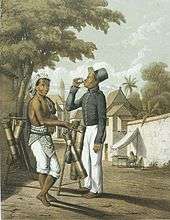
Tuak is imbibed in Sumatra, Sulawesi, Kalimantan and Bali of Indonesia and parts of Malaysia such as Sabah and Sarawak in East Malaysia. The beverage is a popular drink among the Kadazan-Dusun, Ibans and the Dayaks during the Gawai and Kaamatan festivals, weddings, hosting of guests and other special occasions. The Batak people of North Sumatra also consume palm wine, with the palm sap is mixed with raru bark to make Tuak. The brew is served at stalls along with snacks.[1] The same word is used for other drinks in Indonesia, for example, those made using fermented rice.
Mexico
Mexican tuba made from coconut sap is common in western Mexico, especially in the states of Colima, Jalisco, Michoacán, and Guerrero. Coconuts are not native to the Americas. They were introduced to Mexico from the Philippines via the Manila Galleons to Acapulco, along with tuba manufacturing.[9][10][11] Mexican tuba is made in the same way as Filipino tubâ. The traditional sap collectors are known as tuberos (which also means "plumber" in both Mexico and the Philippines). It became so popular that in 1619, Captain Sebastian de Piñeda wrote to King Philip III of Spain complaining of the Filipino "Indio" settlers in Nueva España who were causing significant loss of profits to Iberian alcohol exporters due to tuba.[12][13]
Mexican tuba is also commonly sold as tuba fresca, a non-alcoholic version made from fresh coconut sap. It is traditionally sold by street vendors in large bottle gourds mixed with coconut milk, ice, and sugar. It is usually topped with peanuts and diced fruit.[14][15]
Philippines
Palm wines are widely consumed in the Philippines and are part of the traditional palm vinegar industry. They are gathered mostly from coconuts, nipa palms, or kaong palms. Palm wines fermented for a few days to a few weeks are generally referred to as tubâ. There are two notable traditional derivations of tubâ with higher alcohol contents. The first is the lambanog of Luzon island in the northern Philippines that distilled and is milky white to clear in colour. The second, is the bahalina of the Visayas and Mindanao islands which is typically deep brown-orange in colour due to the use of bark extracts from the mangrove Ceriops tagal.[6][7]
Other types of palm wines indigenous to the islands include subtypes of tubâ like tuhak or tubâ sa hidikup which is made from kaong palm sap, and tunggang which is made from fishtail palm sap.[7]
South America
Production of palm wine may have contributed to the endangered status of the Chilean wine palm (Jubaea chilensis).[16]
Other areas
In Tuvalu, the process of making toddy can clearly be seen with tapped palm trees that line Funafuti International Airport. In Kiribati it is called Karewe and freshly tapped sap from coconut spathe is used as a refreshing drink and the fermented sap is used as an alcoholic beverage. Karewe is boiled to reduce into a thick light brown liquid, called kamwaimwai, used as sweetener and spread.
Consumption by animals
Some small pollinating mammals consume large amounts of fermented palm nectar as part of their diet, especially the southeast Asian pen-tailed treeshrew. The inflorescences of the bertam palm contain populations of yeast which ferment the nectar in the flowers to up to 3.8% alcohol (average: 0.6%). The treeshrews metabolise the alcohol very efficiently and do not appear to become drunk from the fermented nectar.[17]
Bats have been known to drink from containers of harvested palm sap, and also excrete into the containers, leading to disease transmission of Nipah virus.
Names
There are a variety of regional names for Palm wine:
| State / Territory / Region | Name used |
|---|---|
| Algeria / Tunisia | lāgmi (لاقمي in Arabic). Used for both the alcoholic and nonalcoholic form |
| Bangladesh | তাড়ি taṛi, তাড়ু taṛu, tuak[18] |
| Benin | sodavi (distilled) |
| Cambodia | Tuk tnout choo[19] |
| Cameroon | mimbo,[20] matango, mbuh, tumbu liquor, white stuff |
| People's Republic of China | 棕榈酒 (pronounced- zōng lǘ jiǔ)[21] |
| Democratic Republic of the Congo | malafu ya ngasi (Kikongo), masanga ya mbila (Lingala), vin de palme |
| Gabon | toutou |
| Gambia | singer |
| Ghana | doka, nsafufuo, palm wine, yabra, dεha (pronounced der 'ha), tér daññ |
| Guam | tuba |
| India |
|
| Indonesia | arak,[18] tuak in Indonesia. Especially in Batak region, North Sumatra, where the traditional bar serving tuak called lapo tuak. In South Sulawesi (especially in Tana Toraja) it is called ballo', and in North Sulawesi saguer. |
| Ivory Coast | Bandji, koutoukou (when it is further distilled) |
| Kenya | Mnazi (which means coconut palm) |
| Kiribati | Karewe |
| Libya | lāgbi [ˈlaːɡbi] (لاقبي in Arabic).. Used for both the alcoholic and nonalcoholic form. |
| Mali | bandji, sibiji, chimichama |
| Malaysia | Nira (Malay for fresh juice obtained from the blossom of the coconut, palm or sugar-palm, which can be made into sugar or the said palm wine, which is also known as Tuak[18]), toddy (English), bahar (Kadazan/Dusun), goribon (Rungus) |
| Maldives | Dhoaraa, Rukuraa, Meeraa |
| Myanmar | htan yay |
| Mexico | tuba (garnished with peanuts), originated from the Philippines |
| Namibia | omulunga, palm-wine |
| Nepal | Taari, तारि |
| Nigeria | Palm-wine, Palmy, Ukọt nsuñ, Mmin efik, Emu, Oguro, Tombo liquor, Mmanya ngwo, Nkwu enu, Nkwu Ocha. |
| Papua New Guinea | segero, tuak |
| Philippines | tubâ, soom,[18] lambanóg (distilled tubâ), bahalina (Waray Visayan) |
| South Africa | ubusulu, injemane |
| Seychelles | kalou |
| Sierra Leone | poyo, mampama |
| Sri Lanka | Raa(Sinhala), kallu (கள்ளு), panam culloo[18] |
| Tanzania | pómbe (which means alcohol) or tembo[22] |
| Thailand | kache, namtanmao |
| Tunisia / Algeria | Lāgmi. Used for both the alcoholic and nonalcoholic form |
| East Timor | tuaka and tua mutin, brandy is called tua sabu |
| Tuvalu | kaleve (unfermented), kao (fermented), or in English, toddy (unfermented), sour toddy (fermented) |
| Viet Nam | rượu dừa;[18] ruou dua ; coconut wine |
Gallery
 Bowl for tuak drinking made from a gourd (late 19th century)
Bowl for tuak drinking made from a gourd (late 19th century) Tapping the sap of the immature flower flasks in "arènpalm" (Arenga pinnata), one of the palms used to make palm wine, in Ambon, Moluccas (1919). The wine was called toewak (Dutch), tuak or sagoweer (saguer). The fresh sap, "sugar water", was also so drunk.
Tapping the sap of the immature flower flasks in "arènpalm" (Arenga pinnata), one of the palms used to make palm wine, in Ambon, Moluccas (1919). The wine was called toewak (Dutch), tuak or sagoweer (saguer). The fresh sap, "sugar water", was also so drunk._op_Bali_TMnr_10002905.jpg) Palm wine seller in Bali (1929)
Palm wine seller in Bali (1929)- Taken in Southern Leyte, Philippines where a tuba gatherer climb the coconut tree to harvest some tuba.
- Sitting on the coconut palm while gathering tuba.
- Locally called "manananggot" for tuba gatherer.
- Gathering tuba from the coconut tree.
 Group photo of 'Thiyyar',the traditional toddy tapping community of Northern kerala.
Group photo of 'Thiyyar',the traditional toddy tapping community of Northern kerala. Toddey tappers (Mergu Ravi and Burra Rajamallu) in Telangana, India.
Toddey tappers (Mergu Ravi and Burra Rajamallu) in Telangana, India. Somaraju Mergu climb the toddey for palm wine(toddey water) in state of Telangana, India.
Somaraju Mergu climb the toddey for palm wine(toddey water) in state of Telangana, India. Cocoanut trees, and Toddy gatherers of Southern India (1855)
Cocoanut trees, and Toddy gatherers of Southern India (1855)
In popular culture
The tapping and consumption of palm wine are recurrent motifs in the Chinua Achebe novel Things Fall Apart,[23] and in the Amos Tutuola novel The Palm-Wine Drinkard.[24]
See also
- Desi daru
- Pulque
- Arrack, an alcoholic beverage distilled from coconut palm wine in southeast Asia.
- Palm-wine music, a West African musical genre.
- Coyol wine
- Ogogoro
- Madurai Veeran, a deity who consumes toddy.
- Sree Muthappan, another deity who consumes toddy.
- List of Indonesian beverages
References
Notes
- Enjoying ‘tuak’ in Batak country by Wan Ulfa Nur Zuhra, NORTH SUMATRA, Feature, 21 January 2013 Jakarta Post
- Rundel, Philip W. The Chilean Wine Palm Archived 4 January 2006 at the Wayback Machine in the Mildred E. Mathias Botanical Garden Newsletter, Fall 2002, Volume 5(4). Retrieved 31 August 2008
- Confirel:Sugar Palm Tree – Conservation of natural heritage. Retrieved 15 April 2012
- Toddy and Palm Wine – Practical Answers on the Practical Action website. Retrieved 31 August 2008
- "Fermented and vegetables. A global perspective. Chapter 4". fao.org. Retrieved 5 February 2018.
- "How Tuba and Bahalina, Also Known as Coconut Wine, Are Made". Delishably. Retrieved 21 April 2019.
- Sanchez, Priscilla C. (2008). Philippine Fermented Foods: Principles and Technology. UP Press. pp. 151–153. ISBN 9789715425544.
- "WebHost4Life". indianwine.org. Retrieved 5 February 2018.
- Astudillo-Melgar, Fernando; Ochoa-Leyva, Adrián; Utrilla, José; Huerta-Beristain, Gerardo (22 March 2019). "Bacterial Diversity and Population Dynamics During the Fermentation of Palm Wine From Guerrero Mexico". Frontiers in Microbiology. 10: 531. doi:10.3389/fmicb.2019.00531. PMC 6440455. PMID 30967846.
- Veneracion, Jaime (2008). "The Philippine-Mexico Connection". In Poddar, Prem; Patke, Rajeev S.; Jensen, Lars (eds.). Historical Companion to Postcolonial Literatures – Continental Europe and its Empires. Edinburgh University Press. p. 574. ISBN 9780748630271.
- Mercene, Floro L. (2007). Manila Men in the New World: Filipino Migration to Mexico and the Americas from the Sixteenth Century. UP Press. p. 125. ISBN 9789715425292.
- Gibbs, H.D.; Holmes, W.C. (1912). "The Alcohol Industry of the Philippine Islands Part II: Distilled Liquors; their Consumption and Manufacture" (PDF). The Philippine Journal of Science: Section A. 7: 19–46.
- "Culture of Colima". Explorando Mexico. Retrieved 5 May 2019.
- Esparza, Bill (28 May 2015). "Beyond Aguas Frescas: Two Refreshing Mexican Coolers to Try This Summer". Los Angeles Magazine. Retrieved 5 May 2019.
- "Talking Tuba". Vallarta Today. Retrieved 5 May 2019.
- C. Michael Hogan. 2008. Chilean Wine Palm: Jubaea chilensis, GlobalTwitcher.com, ed. N. Stromberg Archived 17 October 2012 at the Wayback Machine
- Frank Wiens, Annette Zitzmann, Marc-André Lachance, Michel Yegles, Fritz Pragst, Friedrich M. Wurst, Dietrich von Holst, Saw Leng Guan, and Rainer Spanagel. Chronic intake of fermented floral nectar by wild treeshrews Proceedings of the National Academy of Sciences. Published online before print 28 July 2008. Retriev 25 August 2008
- Law, S.V.; et al. (2011). "MiniReview- Popular fermented foods and beverages in Southeast Asia" (PDF). International Food Research Journal (18). Retrieved 20 January 2012.
- Gnarfgnarf:Palm wine, rice wine, grape wine, beers and other drinks and beverages of Cambodia, 9 April 2012. Retrieved 15 April 2012
- Anchimbe – Creating New Names for Common Things in Cameroon English (I-TESL-J)
- "English-Chinese Translation of "palm wine"". Websaru Dictionary. Retrieved 20 January 2012.
- Rough Guides (2015). The Rough Guide to Tanzania. Rough Guides UK. ISBN 978-0-241-23749-6.
- Achebe, Chinua. Things Fall Apart. UK: William Heinemann Ltd., 1958.
- Tutuola, Amos. The Palm-Wine Drinkard. Grove Press, 1954.
